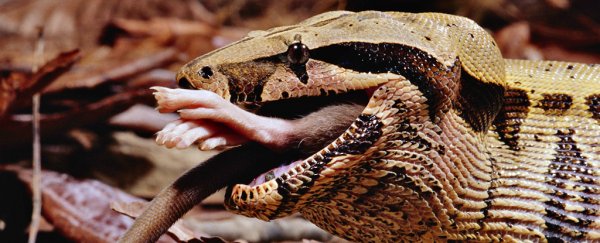Powerful ambush hunters, Boa constrictor snakes are notorious for brutally incapacitating their prey – by squeezing them to death before swallowing them whole. Researchers have just discovered how the snakes achieve this without suffocating themselves.
Contrary to popular belief, these nonvenomous reptiles actually kill their victims by choking off the blood flow to their heart and brain, rather than suffocation. This technique – along with super-stretchy jaws – allows them to take down relatively large prey, including wild pigs, monkeys, and ocelots from their forested homes in Central and South America.
But snakes have no diaphragm – the thin layer of muscle mammals like us contract to move air in and out of lungs – so they rely entirely on their rib muscles to breathe. This means when those muscles are busy squashing something externally or squeezing food through their tubular bodies, snakes can't move air around, too.
Yet these nocturnal nope ropes increase oxygen consumption by almost 7 times while subduing their victims compared to resting rates, and up to 17 times to digest prey a quarter of their own body weight. How boa constrictors manage to squeeze the life out of another animal for up to 45 minutes, yet still are able to breathe, has been a long-standing mystery.
Researchers led by evolutionary biologist John Capano from Brown University used blood pressure cuffs to figure out what happens when different parts of a danger noodle are squished – which sounds like a risky task.
"Either the animals did not mind the cuff or became defensive and hissed to try to get the researcher to leave," recalls Capano, explaining that the reptiles filled their lungs to hiss, providing the team with the perfect opportunity to measure some big breaths.

By compressing the cuff along different points, the team could assess and reconstruct how the boa's ribs moved. When the ribs closest to the snake's head were stifled by the gripping cuff, ribs further towards its tail started to heave in and out.
If the cuff gripped those further back ribs, the front part of the snake would take on the motion.
So, boa constrictors can alter which part of their rib cage is doing their breathing movements – saving themselves from suffocating when their default breathing muscles are otherwise occupied.
Capano and colleagues have dubbed this newfound ability 'modular lung ventilation', and suspect it evolved before snakes began constricting their prey.
While long, noodle-shaped bodies have evolved at least 65 times amongst animals with backbones, snakes have the most stunning array of diversity out of all these groups, with nearly 4,000 known species. Some researchers have suggested snakes' ability to take down a large victim and swallow it whole may have been what gave these animals their edge, by allowing them to consume a greater variety of prey.
Capano and team note modular lung ventilation would have been a key feature in snake evolution: "This remarkable ability to subdue and consume such massive prey may have facilitated entry into novel ecological niches."
This research was published in the Journal of Experimental Biology.
